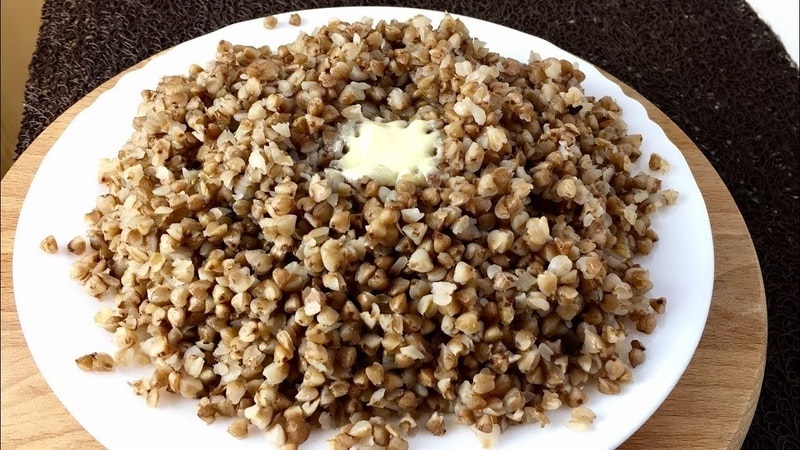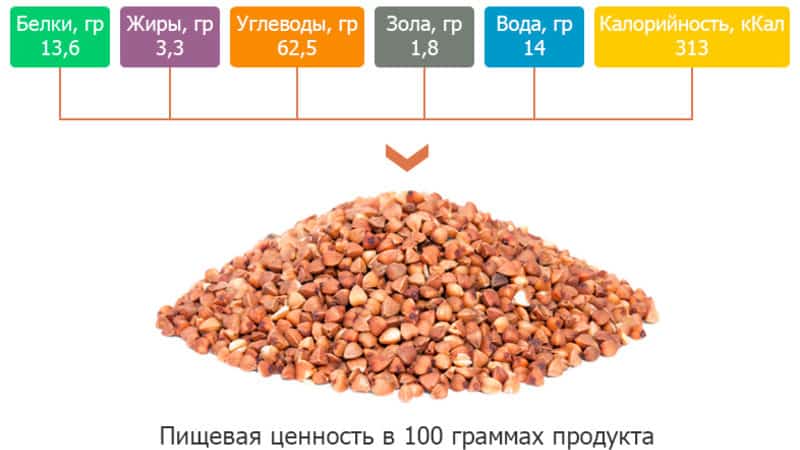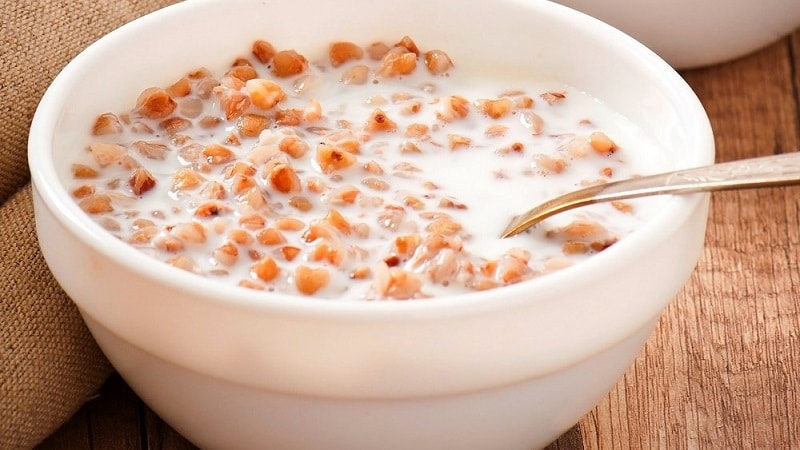Calorie content of buckwheat: how many calories are in a plate of buckwheat prepared in different ways
Buckwheat contains many useful and nutritious substances. It is often used when dieting. The calorie content of this product depends on how it is prepared. The article examines the nutritional value of buckwheat porridge depending on the method of preparation.
How many calories are in a plate of boiled buckwheat (with salt and water)
Buckwheat - Is it filling. However, at the same time, it is low in calories. 100 grams of dry cereal contains 313 kcal. After cooking, its volume increases three times.
100 g of boiled cereal contains 104 kcal, 150 g - 157 kcal, 200 g - 207 kcal.

Cooking porridge is carried out as follows:
- The cereal is washed in cold water.
- Fill with water.
- Place on low heat and cover with a lid.
Important! When cooking cereals, almost all useful substances are destroyed, so it is recommended to pour boiling water over them. For one part of cereal take two parts of water. The container must have thick walls.
Salt has no effect on the calorie content of a dish. However, it retains fluid in the body. To lose weight faster, it is recommended to eat porridge without salt.
With butter
If you add butter to boiled buckwheat, its calorie content increases. When adding 5 grams of butter, 100 grams of cereal boiled in water contains 130-135 kcal.
With milk
Use buckwheat with milk has a beneficial effect on the body.This dish strengthens the heart and nervous system, improves blood supply to the liver, and prevents bile stagnation.
100 grams of boiled buckwheat with milk with a fat content of 3.2%, without butter and sugar, contains 120 kcal.
In steamed buckwheat without salt
Steamed buckwheat is more valuable for the body than boiled buckwheat due to the content of a large amount of proteins, amino acids and minerals.
100 grams of cereal steamed in water contains 101 kcal.
Calorie content per 100 grams
Below is the calorie content of raw and boiled buckwheat in water in a tablespoon and in a teaspoon.
In a tablespoon
One tablespoon of boiled buckwheat contains 30 kcal.
One tablespoon of dry cereal contains 80 kcal.
Important! The calculations use the weight of a heaped spoonful of buckwheat to make it more convenient to carry out calculations.
In a teaspoon
One teaspoon of boiled buckwheat contains 12 kcal, and one teaspoon of dry cereal contains 25 kcal.

BJU
Below is the content in boiled and raw buckwheat proteins, fats and carbohydrates per 100 g:
- Proteins: raw - 12.6, boiled - 3.6.
- Fats: raw - 3.3, boiled - 2.3.
- Carbohydrates: raw: 57.1, boiled - 17.1.
Chemical composition
Buckwheat ranks first among other cereals in terms of protein content. There are 18 amino acids in the cereal. Among them are lysine, tryptophan, arginine, glycine, tsvalin.
Among the vitamins, the product in question contains: tocopherol, nitsain, riboflavin, pyridoxine, folic acid.
Included in microelements: potassium, phosphorus, magnesium, sulfur, macroelements - silicon, iron, zinc, copper.
Benefits and harms
Among useful properties buckwheat stand out:
- reducing the risk of malignant tumors;
- increasing the body's resistance to adverse external factors;
- prevention of thrombosis;
- mental state improves;
- blood sugar levels stabilize;
- hormonal dysfunctions are prevented;
- intestinal motility improves;
- bone tissue is strengthened;
- heart rate stabilizes.
Despite its benefits, buckwheat can be harmful. If you eat it in unlimited quantities, it can negatively affect the state of the digestive system. Gas formation, bloating and stomach cramps may occur.
Should those who are losing weight eat buckwheat?
If you want to lose extra pounds, you can eat buckwheat porridge. There are various options for buckwheat diets.
Important! Experts do not recommend sticking to a buckwheat mono-diet for more than 5 days. This is dangerous to your health.
If you eat only buckwheat porridge, then you can throw it off from 2 to 10 kg per week. The specific number of kilograms depends on the individual characteristics of the body.
Calorie content of dishes with buckwheat
To ensure a complete and balanced diet, it is recommended to consume this porridge in combination with other products. Below is the calorie content of buckwheat porridge along with chicken breast, as well as buckwheat on kefir.

How many kcal are in buckwheat with chicken breast
Buckwheat in combination with boiled chicken breast is a classic healthy option. This combination provides the body with the necessary vitamins and minerals. For preparation you need:
- 2 cups buckwheat;
- chicken fillet - 500 g;
- 2 pcs. carrot;
- 1 PC. onion;
- salt 2 g;
- water 4 glasses.
Cooking process:
- Boil the chicken breast.
- Rinse the buckwheat in cold water, add water and cook.
- Peel and wash the carrots and onions.
- Grate the carrots and finely chop the onion.
- Fry vegetables for 3 minutes.
- Cut the boiled breast into cubes and mix with vegetables.
One serving weighing 234 g contains 211 kcal. 100 g - 91 kcal.
Buckwheat on kefir
Buckwheat with kefir reduces the amount of bad cholesterol in the body and has a low glycemic index. This dish allows you to quickly lose extra pounds without harm to your health. To prepare it you need:
- 2 tbsp. l. Rinse buckwheat in cold water.
- Pour 1 cup of kefir over the washed cereal.
- Cover the container with a lid and put it in the refrigerator overnight.
The cereal will swell by morning. It can be eaten.
100 grams of buckwheat in a glass of 1% kefir contains 60 kcal.
Conclusion
Buckwheat is a healthy and nutritious product. It contains a large number of useful substances. The dishes in question are recommended for those who are on a diet. However, everything is good in moderation - don’t get carried away with mono-diets, eat a varied diet. Consultation with a nutritionist is recommended.